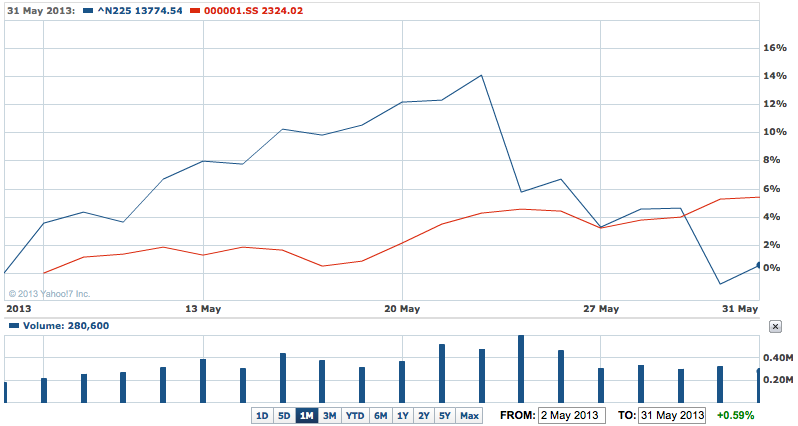Amid all the hype and type about quantitative easing, Fed easing/tightening, falling gold, oil, nervous investors and rising bond yield, there was an unlikely winner of the best performed major stock market last month – China.
Yes, the Shanghai market rose more than 6% last month and China’s currency, the yuan, rose half a percent which doesn’t sound much, but currencies across the rest of Asia fell in May as the yen’s weakness spread and the US dollar strengthened.
The strength in China came despite a spate of stories about how growth was slowing, financial problems rising and the government was hamstrung by limited options in looking to keep demand buoyant.
China’s strength belied the negative sentiment about the economy among foreign investors.
That negative sentiment was evident in Australia where the local market fell 5.1% last month.
Japan’s Nikkei fell 2% last month, thanks to those big falls on successive Thursdays in the last two weeks of the month. That pushed the Tokyo market into correction territory.
But Tokyo is still up 40% so far this year. In contrast, the Shanghai market has only managed a 2% gain.
May – Shanghai Composite Vs Nikkei

Saturday’s news of slightly stronger activity among major manufacturers in May will add to the impression that the gloom about China has been a touch overdone.
But then the best indicator of Chinese economic health for the Australian market – spot iron ore prices – had a bad month in May.
Iron ore prices dropped 13.7% last month from a high of $US130.20 on May 8 to $111.60. So far in April and May iron ore prices are 22% down on the average for the March quarter.
Spot gold fell 3.9% and spot silver 6.2% for the month.That was after the big losses in April.
And oil prices fell 1.6% (for US crude futures) and nearly 2% for Brent futures in London.
The strength of the US dollar played the major part in the weakness in oil prices, and was part of the story for gold where the sell-off was helped by investor fatigue and profit taking.
The Aussie dollar ended at 96.71 USc on Saturday morning, our time, and fell by around 5% last month – another victim (finally) of the stronger US dollar, investors catching up with the weaker economy and the May 7 rate cut from the Reserve Bank.
The currency went from a high of 102.51 USc on May 9 to a low of 95.30USc last week.
In New York Wall Street finished May with a lot of blah – a 208 point loss for the Dow, 23.6 points for the S&P 500 and 35.4 points for the Nasdaq.
For the week the Dow fell 1.2%, the S&P 500 lost 1.1% and the Nasdaq dipped 0.1%.
For May, the Dow rose 1.9% and the Nasdaq gained 3.8%.
The S&P 500 ended May up 2.1%, its seventh straight month of gains and its longest ‘up’ streak since 2009.
The Dow has risen for the past six months in a row.
But the S&P 500, the best measure of US market performance, is still up 14.5% so far in 2013.
In the US, bond yield jumped sharply – from 1.61% at the start of the month to 2.20% on Friday (and as high as 2.23%) as the gradual improvement in the health of the US economy became apparent and investors started trying to anticipate just when the Fed would start reducing its $US85 billion a month of purchases.
That will again be the big issue for markets in June.
The surge in US bond yields (and price falls, producing big losses for investors) saw yields in Europe rise and in Japan, where the huge spending plans of the Abe government and the Bank of Japan saw 10 year bond prices fall sharply on four separate occasions.
That forced the Bank of Japan into buying bonds to cap the rise in yields and prevent them from breaching the 1% level, which is considered to have considerable importance.
That’s another thing to watch closely. Japanese bond yields are an important indicator of nervousness among big investors about the country’s attempts to escape its deflationary trap.
Data out Friday showed the country still has a way to go – core inflation in April was minus 0.4%, marginally better than March’s reading of minus 0.5%.
The target for the government and the Bank of Japan is 2% positive inflation.
In other words, there still is a long way to go. If the government achieves its target level for inflation, interest rates will have to rise sharply, which will pressure activity in the wider economy.
This could end up very destabilising because rising interest rates will see the yen rise, choking off the rebound in exports, which are the main economic driver of growth in Japan.













